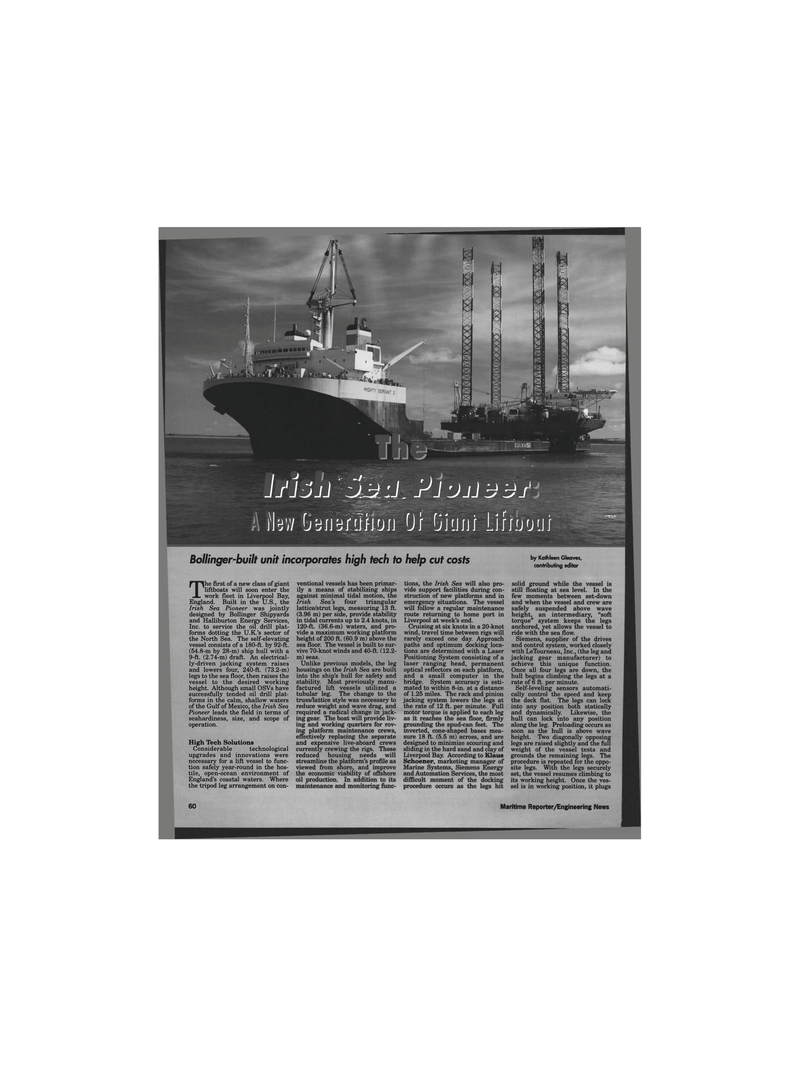
Page 59: of Maritime Reporter Magazine (November 1995)
Read this page in Pdf, Flash or Html5 edition of November 1995 Maritime Reporter Magazine
Jyjjjj k£iut Pj^jj^^y
Mi ijbuhMm Of DiiJui iif/ijfjyi • TCt •
Bollinger-built unit incorporates high tech to help cut costs by Kathleen Gleaves, contributing editor
The first of a new class of giant liftboats will soon enter the work fleet in Liverpool Bay,
England. Built in the U.S., the
Irish Sea Pioneer was jointly designed by Bollinger Shipyards and Halliburton Energy Services,
Inc. to service the oil drill plat- forms dotting the U.K.'s sector of the North Sea. The self-elevating vessel consists of a 180-ft. by 92-ft. (54.8-m by 28-m) ship hull with a 9-ft. (2.74-m) draft. An electrical- ly-driven jacking system raises and lowers four, 240-ft. (73.2-m) legs to the sea floor, then raises the vessel to the desired working height. Although small OSVs have successfully tended oil drill plat- forms in the calm, shallow waters of the Gulf of Mexico, the Irish Sea
Pioneer leads the field in terms of seahardiness, size, and scope of operation.
High Tech Solutions
Considerable technological upgrades and innovations were necessary for a lift vessel to func- tion safely year-round in the hos- tile, open-ocean environment of
England's coastal waters. Where the tripod leg arrangement on con- ventional vessels has been primar- ily a means of stabilizing ships against minimal tidal motion, the
Irish Sea's four triangular lattice/strut legs, measuring 13 ft. (3.96 m) per side, provide stability in tidal currents up to 2.4 knots, in 120-ft. (36.6-m) waters, and pro- vide a maximum working platform height of 200 ft. (60.9 m) above the sea floor. The vessel is built to sur- vive 70-knot winds and 40-ft. (12.2- m) seas.
Unlike previous models, the leg housings on the Irish Sea are built into the ship's hull for safety and stability. Most previously manu- factured lift vessels utilized a tubular leg. The change to the truss/lattice style was necessary to reduce weight and wave drag, and required a radical change in jack- ing gear. The boat will provide liv- ing and working quarters for rov- ing platform maintenance crews, effectively replacing the separate and expensive live-aboard crews currently crewing the rigs. These reduced housing needs will streamline the platform's profile as viewed from shore, and improve the economic viability of offshore oil production. In addition to its maintenance and monitoring func- tions, the Irish Sea will also pro- vide support facilities during con- struction of new platforms and in emergency situations. The vessel will follow a regular maintenance route returning to home port in
Liverpool at week's end.
Cruising at six knots in a 20-knot wind, travel time between rigs will rarely exceed one day. Approach paths and optimum docking loca- tions are determined with a Laser
Positioning System consisting of a laser ranging head, permanent optical reflectors on each platform, and a small computer in the bridge. System accuracy is esti- mated to within 8-in. at a distance of 1.25 miles. The rack and pinion jacking system lowers the legs at the rate of 12 ft. per minute. Full motor torque is applied to each leg as it reaches the sea floor, firmly grounding the spud-can feet. The inverted, cone-shaped bases mea- sure 18 ft. (5.5 m) across, and are designed to minimize scouring and sliding in the hard sand and clay of
Liverpool Bay. According to Klaus
Schoener, marketing manager of
Marine Systems, Siemens Energy and Automation Services, the most difficult moment of the docking procedure occurs as the legs hit solid ground while the vessel is still floating at sea level. In the few moments between set-down and when the vessel and crew are safely suspended above wave height, an intermediary, "soft torque" system keeps the legs anchored, yet allows the vessel to ride with the sea flow.
Siemens, supplier of the drives and control system, worked closely with LeTourneau, Inc., (the leg and jacking gear manufacturer) to achieve this unique function.
Once all four legs are down, the hull begins climbing the legs at a rate of 6 ft. per minute.
Self-leveling sensors automati- cally control the speed and keep the deck flat. The legs can lock into any position both statically and dynamically. Likewise, the hull can lock into any position along the leg. Preloading occurs as soon as the hull is above wave height. Two diagonally opposing legs are raised slightly and the full weight of the vessel tests and grounds the remaining legs. The procedure is repeated for the oppo- site legs. With the legs securely set, the vessel resumes climbing to its working height. Once the ves- sel is in working position, it plugs 60 Maritime Reporter/Engineering News

 58
58

 60
60
